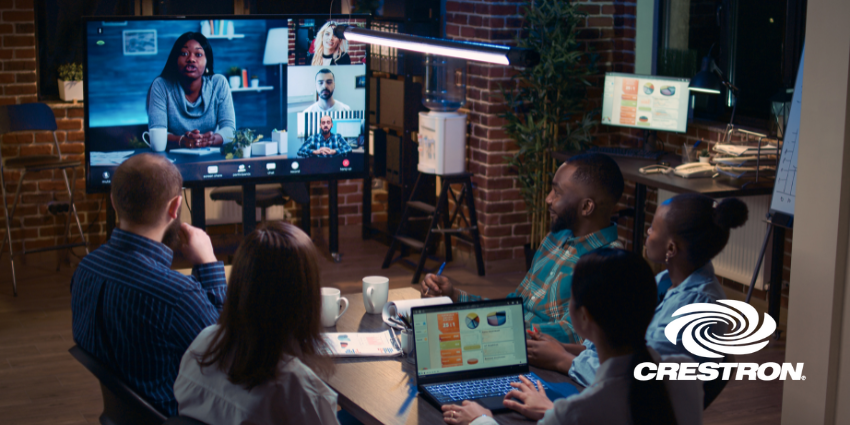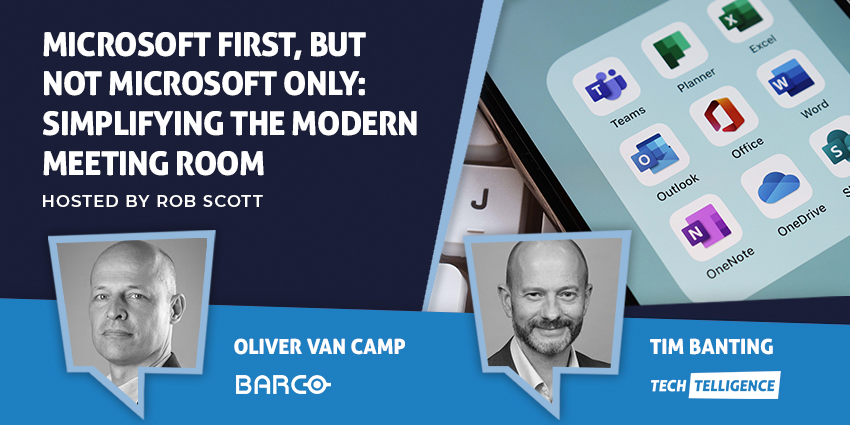AI interest is burning red-hot. Gen AI, AI agents, and AI receptionists are all the rage as companies explore the latest applications.
Although this atmosphere of innovation has many eagerly awaiting new announcements from Microsoft and Zoom, companies not working with the technology as directly are struggling to cut through.
On the UC front, AV has been somewhat sidelined as attention settles on software and service providers.
Yet AV has asserted itself before—transforming from a supporting role into a core part of the meeting experience. Now, it faces the same challenge amid the AI wave: staying indispensable in a world where software dominates.
To explore this, we spoke with Neil Fluester, Head of Portfolio at Logitech for Business, about how AV companies can position themselves as essential players in the AI-driven enterprise landscape.
Rethinking the AV Role in AI Adoption
AV has long been viewed as technology that supports meetings rather than shapes how organizations collaborate and make decisions.
Fluester argues that mindset must change if AV firms want to establish themselves as strategic partners in the age of AI.
He explains that success now depends on redefining purpose:
“If AV companies want to be more than just technology providers, they have to rethink their role,”
Says Fluester.
“It’s not just about delivering microphones, cameras, or fancy meeting room setups anymore. To become essential partners, AV companies should focus on making their solutions the glue that holds together AI-enhanced workspaces and smarter business processes.”
Fluester’s perspective highlights a key shift—from selling tools to enabling outcomes. That shift sets the stage for the next challenge: translating strategic ambition into tangible, human-centered experiences.
Making AI Accessible Through Everyday Tools
One of the biggest obstacles to AI adoption isn’t technical—it’s human. Many employees find AI unfamiliar or intimidating; this is where AV can play a decisive role.
By embedding intelligence into everyday workplace tools, AV vendors can bridge the gap between complex AI capabilities and intuitive user experiences.
As Fluester puts it, AI should blend seamlessly into daily routines, not stand apart from them:
“The strategy is simple: AI should feel as natural as checking email or grabbing coffee by making it accessible and habitual,”
He says.
“The companies leading this charge are baking AI into everyday routines—whether it’s using AI-enabled headsets at home, video bars in conference rooms, or smart streaming assistants after work when they’re playing video games.”
Fluester’s point underscores a powerful truth—familiar experiences accelerate trust. Each time an employee benefits from a headset that intelligently cancels noise or a camera that automatically frames speakers, they build confidence in AI’s reliability.
In this way, AV doesn’t just enable meetings; it normalizes AI adoption through everyday comfort and familiarity.
Delivering Measurable Value Through Intelligent Infrastructure
For enterprises, AI adoption hinges on measurable outcomes like productivity and efficiency. To stay essential, AV vendors must show how their technologies deliver those same results through built-in intelligence.
Fluester notes that AI’s value shines when it eliminates manual effort:
“When AI can remove manual intervention in everyday tasks, it frees up workers’ time to focus on more meaningful work and collaboration.”
He adds that intelligent AV systems already provide practical examples of impact. When AI-enabled technologies automatically release unused bookings by detecting empty meeting rooms, IT teams gain actionable space data. This insight helps facilities leaders rightsize office footprints and repurpose underused spaces—turning AV into a source of measurable cost optimization.
Fluester also highlights partnerships where AV elevates the overall experience:
“By collaborating with platform partners like Microsoft and Zoom to identify speakers in meeting rooms, AV systems make meeting summaries more accurate, relevant, and actionable.”
In doing so, AV not only complements enterprise AI tools but also ensures their promised value—time savings and accuracy—actually materializes in daily workflows.
Beyond discrete features, Fluester believes the next differentiator will be adaptability. Companies want to invest in technology that evolves with AI innovation, not one that blocks it.
“Interoperability empowers organizations to easily integrate next-generation AI features or switch providers without losing core AV functionality,” he explains.
Open standards and compatibility ensure AV remains foundational infrastructure rather than a closed system—positioning vendors to stay relevant as enterprise AI matures.
Securing Strategic Partnership Status
The path for AV companies to remain integral to the AI conversation is clear: focus on outcomes, deliver measurable business value, and align hardware capabilities with evolving platform ecosystems.
As Fluester emphasizes, AV’s greatest opportunity lies in making AI both accessible and sustainable. When vendors move beyond selling equipment to building strategic, interoperable ecosystems, they transform from cost-driven suppliers into long-term innovation partners.
The AV sector has already proven its influence once before in unified communications. By applying the same strategic mindset to AI, AV companies can once again secure their role at the heart of digital transformation—this time, as the bridge between human experience and intelligent technology.







